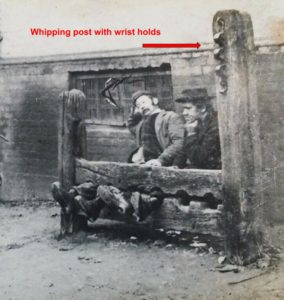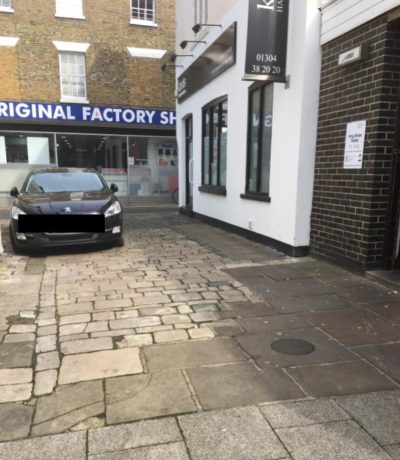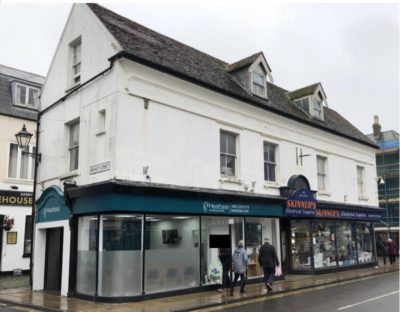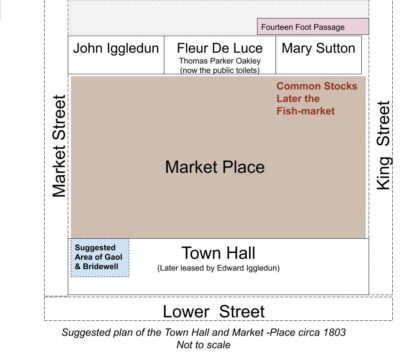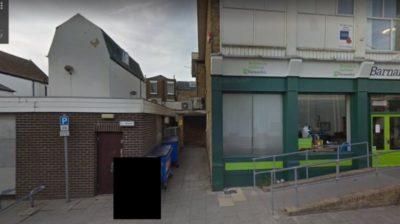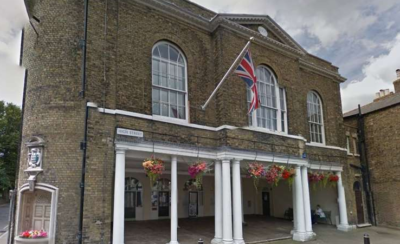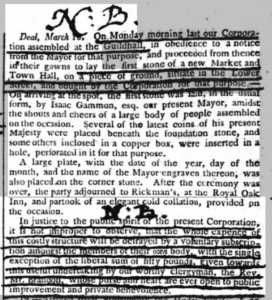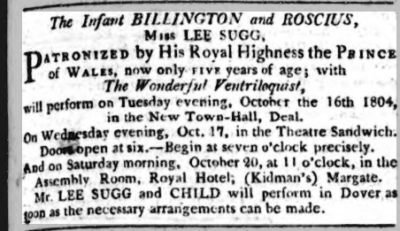Follow us on Facebook @FHofDW
The Town, Guild or Court Hall of Deal
Town, Guild or Court Hall?
At various times the buildings used by the Corporation and later the Borough Council were known as either the Town, Guild or Court Hall. Whichever name was used it is where officials carry on the governance of the town and where the towns-people are able to hold meetings and social gatherings.
We would not, however, have had the need for such a building if Deal had not become a Borough but His Majesty King William 111 granted Deal its Charter of Incorporation in 1699, giving Deal the right to break away from Sandwich and to govern itself.
Charter of Incorporation
Following the granting of Deal’s Charter in 1699, the new Corporation needed a place to meet. Initially, a house was leased and that lease purchased from widow Anna Lawrence on Whetstone (King) Street. It is recorded that on 29 January 1700 the Corporation “… ordered that £40 be paid for the house of Anna Lawrence, widow, for Court Hall and Market-Place” From this house the Corporation would start to perform its administrative duties. The Charter gave the right to hold twice-weekly markets so these were probably amongst the first items of importance to be ordered and organised. The town, as per the Charter, was now responsible for its own law and order so the various courts were established and their officials elected.
~~~~~~~~~~~~~
Markets ~ “…for the buying and selling of all kinds of provisions..” to be held on a Tuesday and Saturday weekly and Fairs to be held three times a year. A court of Pie-Powder was to be held “… in the time of the said market or fair…”.
Sessions of the Peace ~ The Charter says that they “…were intended to be held twice a year, or more often if required…”, for serious crimes happening within the town such as assault, riot and theft. These were the Quarter Sessions
Courts of Record ~ were also to be weekly Courts of Record to deal with general complaints including debts not exceeding £100, trespasses and contracts. These were presided over by the Justices of the Peace.
~~~~~~~~~~~~~~
The Market -Place & Common Stocks
The Market Place was behind the Court Hall and in 1706 the Corporation “ordered that the market be raised and paved.” This was done so that water drained to the north and south of the town along open drains. Presumably, this meant that the area was easier to keep clean, after the market was closed, so excess water used to sluice the market floor, was able to drain away. Some of that paving can still be seen outside King Street public toilets.
Common Stocks ~ A statute of 1351 had made it law for every township to provide and maintain a set of stocks, so having them already means they are not mentioned in the Charter.
Deal’s Common Stocks stood at the edge of the Market-place. They were last mentioned in the Indenture of Lease to Thomas Parker Oakley for the Flower (Fleur) de Luce public house. Mary Sutton lived next door, on the King Street side, and it was near her house that the Stocks were situated.
In 1703 Thomas Powell, in his diary, describes how he put a seaman in the marketplace stocks for “profane swearing.” He also says how he brought a common prostitute to the whipping post, also in the market-place, and “caused her to have twelve lashes” and at every third lash he “parlayed with her” to let all others like her know that “…The Mayor of Deal would serve them as he served her if they came to Deal and committed such wicked deeds as she had done.”
The New Court Hall
Anna Lawrence’s house initially provided the space for the men of the Corporation to meet and plan the future of the town, but it soon proved too cramped for their needs, especially as they were required not just to administer the law but to detain those breaking it. Provisions for a Gaol and its keeper were also included in the Charter.
~~~~~~~~~~
A House of Correction ~ “… to correct and punish all and singular prostitutes, whores and all singular lewd persons and those of bad life and fame, residing or dwelling in the town…and precincts
One Prison or Gaol ~ “… for the … confinement or custody ..of all persons by reason of writ … arrested, or to be arrested… For any felony, trespass, contempt or offence within the town or precincts… perpetrated or committed … to the said prison or gaol to be sent there to remain until …they shall be lawfully and due course of law delivered.”
A Gaol Keeper ~ “…some fit and sufficient man…was to be appointed by the Mayor, Jurats and common councilman…”
~~~~~~~~~
So it was that in 1701 the need for a larger building led to plans being made to build a new Court Hall. As there were still remaining debts to pay in regards to gaining of the Charter it was decided to lay a cess on the town’s inhabitants. Extracts from Thomas Powell’s diary tells us that “Every inhabitant that pays sixpence towards the Poor Rate shall pay towards the liquidating of the debt and the building of the Court Hall …and the same shall continue for the space of a year.” A lease, from the Archbishop, was then taken out on a plot of land on Lower Street extending from Market Street to Whetstone (King) Street, at a sum of £6 a year. Here they built the new Court Hall with a Gaol and Bridewell.
We don’t know exactly what this ‘new’ Court Hall actually looked like. We do know that in 1735 a “Fire and Market-bell” was hung in a cupola on top of the building and that the Gaol was at the Market Street end of the building.
There is a lease for the Court Hall dated 1768, held at Lambeth Palace Archives made between the then Archbishop Frederick Cornwallis and the Mayor, Jurats and Commonality of the town and Borough of Deal. It describes the position of the Court Hall as being to the “…Eastside of the Market Place…Abutting to a lane there called Whetstone Street leading from the Middle Street to the Lower Street towards the South of the Lower Street towards the West to another to the Common Stocks…” It also mentions fourteen feet of ground that must “…remain open and unbuilt upon…” this was to enable ladder room and access so repairs to the stable, situated behind the properties that faced the Market Place, could be made.
Another lease dated 1805 is between the Archbishop Charles Manners-Sutton and the Brewer, Edward Iggledun. The lease again describes the position of the Town Hall but now states “the Market Place…abutting there to towards the West to a thoroughfare now called the Fish Market towards the East to KIng Street Towards the South and to Market Street towards the North consisting of a stone house late the Town Hall Market Place and Gaol….” The lease again mentions the fourteen-foot of ground which is still not built on today.
These ‘compass’ based descriptions are somewhat confusing especially as we don’t know where the people making them stood, or even imagined they were standing when the lease was drawn up.
A New Guildhall
By the early 1800s, the Court hall had become too small and a grander building was needed for the now thriving town. Two pieces of land abutting Lower Street and Chapel Street were purchased from William Wilds and on the 15 March 1803, the first stone was ceremoniously laid by Mayor Isaac Gammon. Coins of the day were placed under the foundation stone. The cost of this new Town Hall was raised by loans and in total cost £2,961 12s 5d. When built the main hall, where the Borough Quarter Sessions were also held, was fifty-seven feet long by twenty-seven feet wide.
The Magistrates Room in which the Petty Sessions were held was apparently “…inconveniently small …” There was also a Council Chamber and “…..The Gaol contains four cells, which are used for temporary purposes; prisoners committed under conviction, or for trial, are sent to Sandwich….”
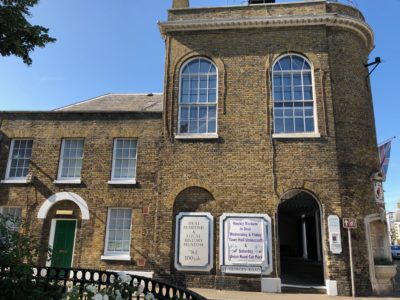 Markets would continue to be held twice a week but now in the Undercroft of the Town Hall and the space outside St. George’s Church where, nearby, stood the towns weighbridge. The Fish Market, which by 1803 seems to have taken over the old Market Place, was open daily. The 1841 census lists victualler John Prescott as living at Fish Market quite possibly in the Fleur De Luce Public House. This later became the Providence which was lost in WW2.
Markets would continue to be held twice a week but now in the Undercroft of the Town Hall and the space outside St. George’s Church where, nearby, stood the towns weighbridge. The Fish Market, which by 1803 seems to have taken over the old Market Place, was open daily. The 1841 census lists victualler John Prescott as living at Fish Market quite possibly in the Fleur De Luce Public House. This later became the Providence which was lost in WW2.
At the Kent History and Library Centre are the original drawings showing the elevations of the new Court Hall and Gaol dated 1803 which show a building that can easily be recognised today. On the side elevation, it shows stairs rising to the first floor, though whether the stairs were actually built we don’t know. There certainly are no visible indications of this on the exterior of the building that we can see.
One of the first public functions to be held at this new Town Hall was in 1804 when it hosted a performance of a Ventriloquist named Lee Suggs and his five-year-old daughter.
Pump & Drinking Fountain
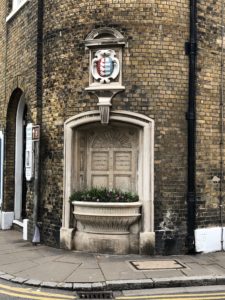 In 1827 a letter was sent by the Commissioners of Deals Pavements to the Corporation requesting the removal of the pump situated on the corner of the Town Hall this presumably was near the present drinking fountain. The letter says that the pump “…was a great nuisance to the pavement in its present situation, & suggests that the same be removed to & placed against the Chapel Wall, a more convenient situation…… B Hulke Clerk to the Comm of Deal Pavement…”
In 1827 a letter was sent by the Commissioners of Deals Pavements to the Corporation requesting the removal of the pump situated on the corner of the Town Hall this presumably was near the present drinking fountain. The letter says that the pump “…was a great nuisance to the pavement in its present situation, & suggests that the same be removed to & placed against the Chapel Wall, a more convenient situation…… B Hulke Clerk to the Comm of Deal Pavement…”
When or if the pump was ever moved we don’t know. There was certainly a pump in the Market Place that drew water from an old well under the Town Hall. This is quite probably the well, known as ‘Bear’s Well’, which was reputed to have had the best drinking water in Deal.
This former working drinking fountain was presented to the Borough of Deal in 1875 by Granville George, Earl Granville, K.G., Lord Warden of the Cinque Ports and is on the corner of Deal Town Hall.
A Storm
In 1836 there was a tremendous storm that caused damage right across Deal & Walmer with some houses losing their roofs. The Town Hall lost its chimney and St. George’s Church its weathervane.
Public Meetings
Public meetings were often held at the Town Hall one such was billed as a ‘Mariners Tea Party’ was held 1858. This was more than a social event for the solution to the poverty which was rife amongst the Boatmen at this time, caused in part by the modernisation and the safety measures for Naval and Merchant shipping, were to be discussed. Emigration was one answer to the problem and an eventual thirteen families were to leave for New Zealand by the end of the year.
In 1882 there was official talk of a third Town Hall being built due to the poor state of the building, including the roof. A meeting called by the town’s ratepayers was held to protest against the proposal it was decided that the Corporation would take out a £400 mortgage to pay for the repairs.
Another held in October 1914 after the arrival of Belgian Refugees was held to organise the Deal and Walmer Belgian Refugees Committee who helped to feed, clothe and house up to 1,500 Refugees during their mostly short stay in Deal & Walmer. A year later during the 85th anniversary of Belgian independence celebrations flags of the Belgian nation were flown from the Town Hall.
Devastating Fire
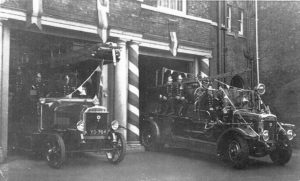 In 1938 there was a fire at the Town Hall that had started in the Council Chamber, then used as a museum, which resulted in considerable damage. The Fire Station at this time adjoined the Town Hall with the engines being housed in the Undercroft. Somewhat embarrassingly brigade members on duty knew nothing of the fire until alerted by a passer-by.
In 1938 there was a fire at the Town Hall that had started in the Council Chamber, then used as a museum, which resulted in considerable damage. The Fire Station at this time adjoined the Town Hall with the engines being housed in the Undercroft. Somewhat embarrassingly brigade members on duty knew nothing of the fire until alerted by a passer-by.
The incident made the national newspapers and one, the News of the World, reported on the struggle to prevent the fire from spreading from the gallery where it had started. Following the fire it was discovered that considerable damage had been done, a valuable oil painting was badly burnt and other exhibits were lost including the Deal Lugger model, built by J Bayly of Middle Street, which had been shown at the Great Exhibition in 1851, though the article incorrectly says 1853!
The Town Hall Today
The Town Hall is now a listed Grade 11 building and is still used by and for the public. Courts are no longer held here though being transferred to Dover in the late 1970s. Consultation and planning meetings continue and now include ‘Marriages, Renewal of Vows, Civil Partnerships, Conversion Ceremonies, Baby Naming and Welcoming Ceremonies.’
At certain times throughout the year, visitors are welcome and annually it opens its doors to the public on Heritage Weekends. On these occasions, you can view the artefacts on display in glass cabinets in the oak-panelled first-floor Council Chamber. At the opposite end of the room, carved into the panelling are the names of all the Mayors of Deal since 1699. High on the walls hang the paintings that survived the fire of 1938. In the Mayor’s Parlour, you can see photos of the Mayors lining the walls, as well as the Charter of Incorporation and the Royal Charter of King William IV. Other items of interest, including the Mace, are often on display there too.
~~~~~~~~
The Mace in the Charter
The Sergeants at Mace ~ “…were good fit men ….in office during one whole year…to officiate in the court…” to process bearing the Mace before the Mayor on civic occasions. To also make “… arrests, pannels of juries, inquests, executions of judgements, warrants and other business…”
The Maces ~ are highly ornamented staffs that the charter says the sergeants at mace shall “…from time to time …shall bear and carry gilt or silver maces, engraved and ornamented with the impression of our royal arms, before the mayor…”

